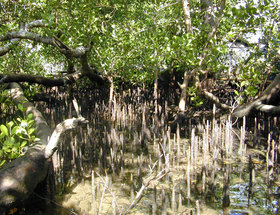Mangrove
|
|
Mangroves.jpg
Mangrove are woody trees or shrubs that grow in coastal habitats or mangal (Hogarth, 1999), for which the term mangrove swamp also would apply. Mangrove plants occupy shallow water and intertidal zones in tropical and subtropical coastal regions, usually where protected from direct wave action, and thus characterized by muddy or fine sediment substrata.
The mangal is often considered a type of biome. Mangrove habitat is exclusively tropical and tidal, and therefore having soil or sediment that is water-logged and saline or of variable salinity. Areas where mangal occurs includes estuaries and marine shorelines. A wide variety of plant species can be found in mangrove habitat, but some 54 species in 20 genera, belonging to 16 families constitute the "true mangroves" — species that occur almost exclusively in mangrove habitats and rarely elsewhere (Hogarth, 1999).
The roots of the mangrove plants stabilize the sand and mud. In areas of the world where mangroves have been removed for development purposes, the coastline has been subject to rapid erosion. They also provide a habitat for wildlife and serve as a natural buffer to strong winds and waves produced by cyclones. In Vietnam, Thailand, the Philippines, and India, mangrove plantations are grown in coastal regions for this purpose. They can protect against tsunamis.

| Contents |
Species of mangroves
The following listing (after Tomlinson, 1986) gives the number of species of mangroves in each listed plant genus and family.
Major components
- Family Avicenniaceae
- Avicennia – 8
- Family Combretaceae
- Laguncularia – 1
- Lumnitzera – 2
- Family Arecaceae
- Nypa – 1
- Family Rhizophoraceae
- Bruguiera – 6
- Ceriops – 2
- Kandelia – 1
- Rhizophora – 8
- Family Sonneratiaceae
- Sonneratia – 5
Minor components
- Family Bombacaceae
- Camptostemon – 2
- Family Euphorbiaceae
- Excoecaria – 2
- Family Lythraceae
- Pemphis – 1
- Family Meliaceae
- Xylocarpus – 2
- Family Myrsinaceae
- Aegiceras – 2
- Family Myrtaceae
- Osbornia – 1
- Family Pellicieraceae
- Pelliciera – 1
- Family Plumbaginaceae
- Aegialitis – 2
- Family Pteridaceae
- Acrostichum – 3
- Family Rubiaceae
- Scyphiphora – 1
- Family Sterculiaceae
- Heritiera – 3
Mangrove ecoregions
| Ecozones |
| Afrotropic | Antarctic | Australasia | Indomalaya | Nearctic | Neotropic | Oceania | Palearctic |
Reference
- Hogarth, Peter J. 1999. The Biology of Mangroves. Oxford Univ. Press. 228 p. ISBN 0198502222
- Thanikaimoni, G. 1986. Mangrove Palynology. UNDP/UNESCO and the French Institute of Pondicherry, 104 p. ISSN 0073-8336 (E).
- Tomlinson, P. B. 1986. The Botany of Mangroves. Cambridge Univ. Press, Cambridge.
- tsunami protection (http://forests.org/articles/reader.asp?linkid=37762)
External link
- The story of the UNESCO Mangrove Programme (http://www.unesco.org/csi/intro/mangrove.htm)
- WWF article about the mangrove biome (http://www.panda.org/about_wwf/where_we_work/ecoregions/global200/pages/habitat/habitat14.htm)
- East African Mangroves (http://www.kenyanmangroves.com)
- Coastal wetland and shoreline change mapping of Pichavaram, south east coast of India using Satellite data (http://www.gisdevelopment.net/application/nrm/coastal/mnm/ma04081pf.htm)
- Status of Indian Mangroves: Pollution Status of Pichavaram Mangrove, Southeast Coast of India (http://landbase.hq.unu.edu/Workshops/OkinawaMarch2000/Papers/Subramanianpapermar2000.htm)
- Mangrove Action Project (http://www.earthisland.org/map/index.htm) - Advocacy group devoted conservation, restoration and sustainable management of mangroves & related coastal ecosystemsde:Mangrove
et:Mangroov es:Manglares fr:Mangrove ja:マングローブ pl:Namorzyny pt:Manguezal sk:Mangrovník
